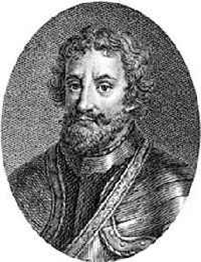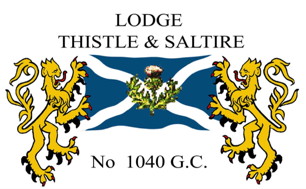The Thistle as Scotland’s national flower is usually associated with  the country and many issues of Scottish origin or relationship. It is little wonder, therefore, that it was adopted as one of the Lodge symboly and part of the name. The Thistle resembles very much a bud, even when it’s in full bloom. Below the obvious meaning as a national symbol it therefore is a picture of the hope of the Founder Members that the Lodge would flourish and develop into a strong community.
the country and many issues of Scottish origin or relationship. It is little wonder, therefore, that it was adopted as one of the Lodge symboly and part of the name. The Thistle resembles very much a bud, even when it’s in full bloom. Below the obvious meaning as a national symbol it therefore is a picture of the hope of the Founder Members that the Lodge would flourish and develop into a strong community.
Not everybody knows that “Saltire” means the diagonal cross of St. Andrew, Scotland’s sacred Patron. Especially foreigners are often puzzled although almost everybody recognizes the Scottish national flag which shows a white cross of St. Andrew - a Saltire - on blue ground. The flag was adopted as a national symbol approximately in  the 14th century. Those related to seafaring will know that the same flag is used as the naval sign for “help”. Not a bad connection for a society which is devoted to Charity.
the 14th century. Those related to seafaring will know that the same flag is used as the naval sign for “help”. Not a bad connection for a society which is devoted to Charity.
The number of a Lodge is the one under which it is listed on the “Roll” - the directory of Lodges kept by the Grand Lodge of which it is a daughter lodge. Usually these numbers are given away one by one but in our case the Grand Master of the United Grand Lodges of  Germany - which keeps the roll of all five partner Grand Lodges - on special request allowed us “1040” instead of a lower number. So the roll number of the Lodge resembles of an important date of Scottish history. On August 14th, 1040 Macbeth killed Duncan I., King of Alba, in the battle of Elgin and crowned himself King. Very different from the dark picture William Shakespeare created in his famous drama, history knows that Macbeth (Gaelic: Mac Bethad mac Findlaích) was in no way a tyrannical, mentally insane dictator. On the contrary he united Scotland under his government and gave the country a peaceful and prosperous period until he died in a battle in 1057, killed by Duncan (III.) who became King after him.
Germany - which keeps the roll of all five partner Grand Lodges - on special request allowed us “1040” instead of a lower number. So the roll number of the Lodge resembles of an important date of Scottish history. On August 14th, 1040 Macbeth killed Duncan I., King of Alba, in the battle of Elgin and crowned himself King. Very different from the dark picture William Shakespeare created in his famous drama, history knows that Macbeth (Gaelic: Mac Bethad mac Findlaích) was in no way a tyrannical, mentally insane dictator. On the contrary he united Scotland under his government and gave the country a peaceful and prosperous period until he died in a battle in 1057, killed by Duncan (III.) who became King after him.
